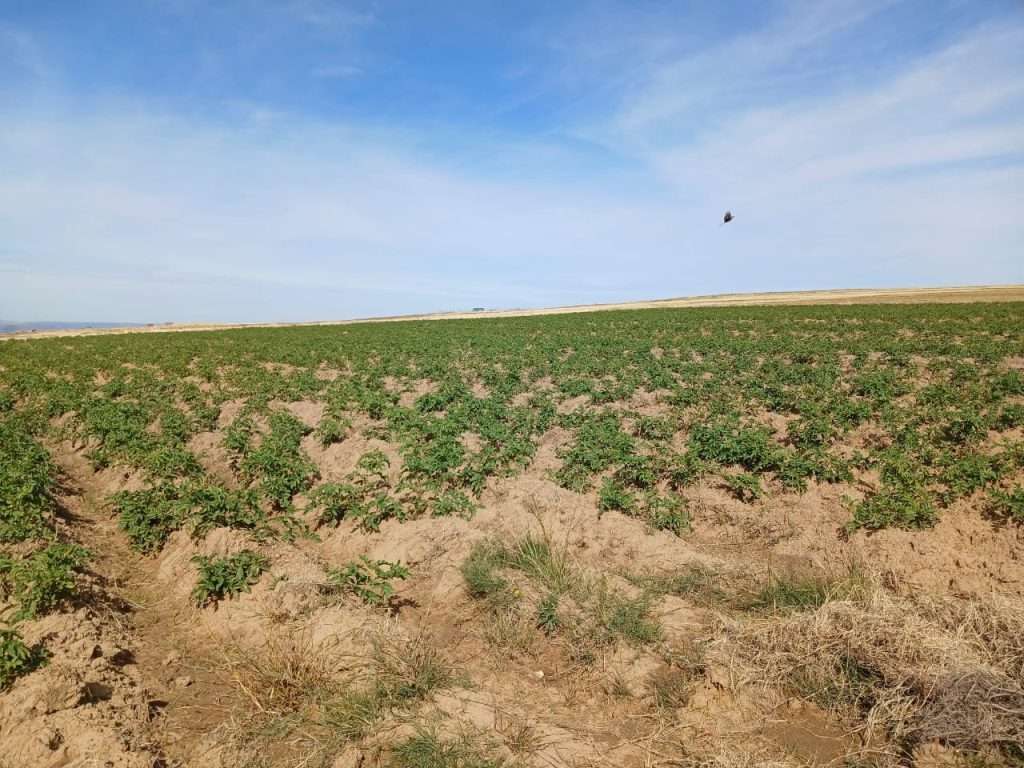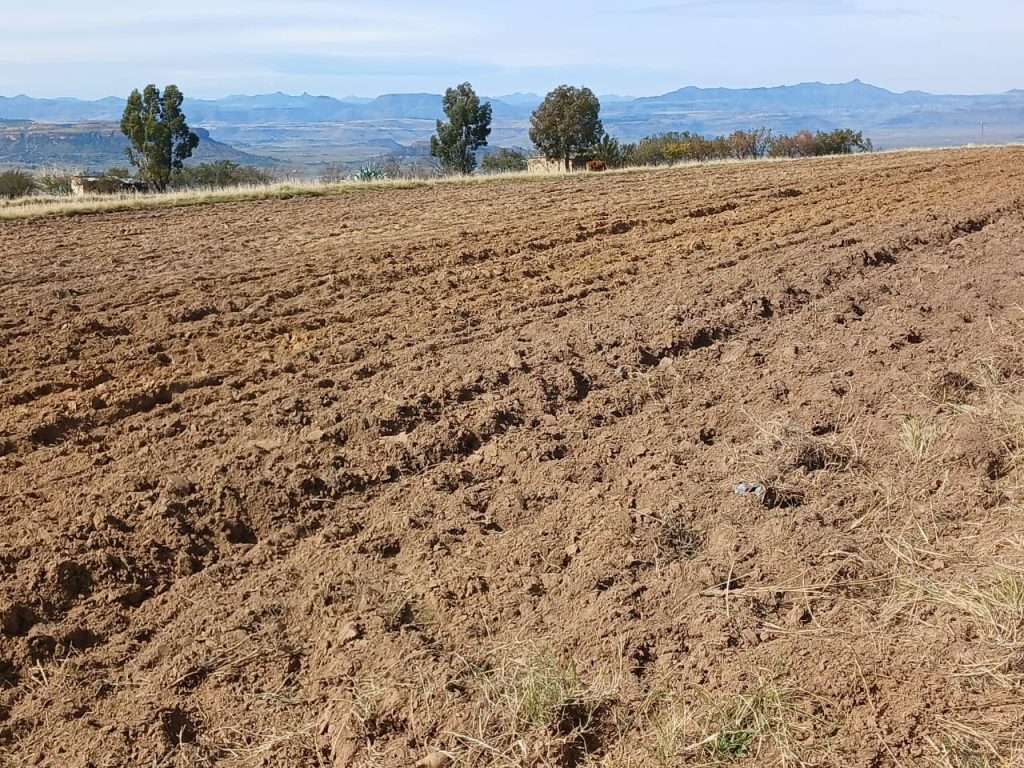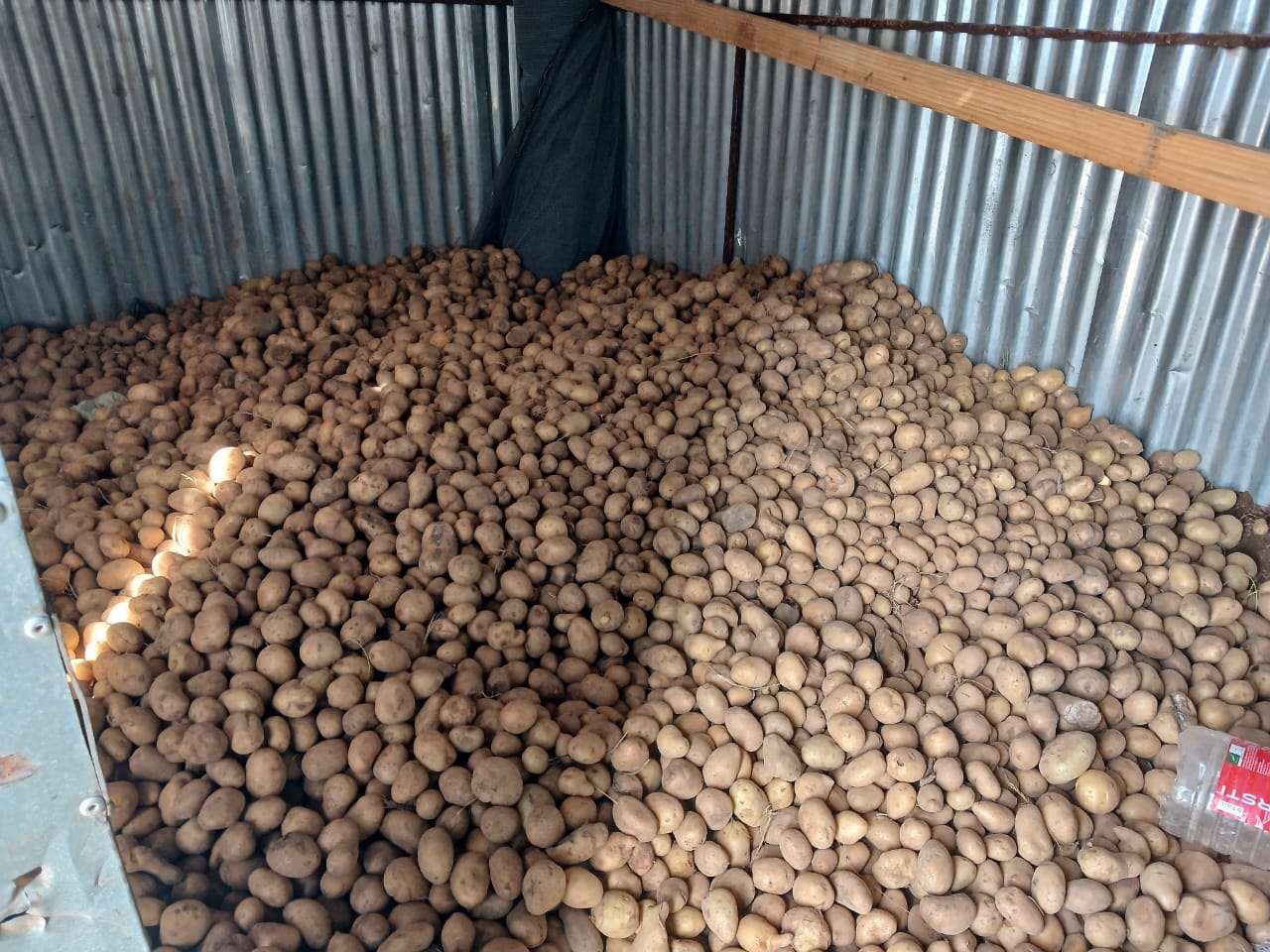Lillane’s Green Success: Adapting with the Machobane Farming System
23 April by Pascalinah Kabi
Est Read Time: 5 min(s) 46 sec(s)
Listen to this article:

A vast potato field tended by farmer Tsikane Lillane. This is the second crop of potatoes, soon to be harvested for consumption. Photo Credit: Pascalinah Kabi
A sea of vibrant green potato leaves blankets the field in Ha Raliele, Sehlabeng-sa-Thuoathe, Berea district, gently swaying to the rhythm of the breeze before Tsikela Lillane, the devoted caretaker. Each leaf, alive and pulsating with vitality, stands as a testament to Lillane’s attentive care and nurturing.
Lillane, born and raised in the rural village of Ha Sechache in Semonkong, Maseru, carries with him a deep connection to the land. Semonkong is renowned for its indigenous potatoes, prized for their unique rich fibre and irresistible flavour that lingers on the palate long after the first bite.
“I grew up around farmers renowned for producing the best potatoes this country can offer,” 34-year-old shared his story with Uncensored News.
From a young age, working alongside seasoned potato producers equipped Lillane with the essential expertise and skills to tend to the field with precision, even amidst changing climatic conditions.
Between January and March 2024, Lesotho and its neighbouring countries in the southern African region faced an intense heatwave.
In Lesotho, the acting director of Lesotho Meteorological Services, Mokoena France, issued a press statement on April 5, 2024, indicating that high temperatures were recorded, especially during the months of February and March 2024.
“Recurring heatwaves were recorded during February and March 2024. This resulted in prolonged dryness which exacerbated the situation,” said France.
The heatwaves led to severe drought conditions, adversely impacting farmers’ yields. A recent rapid attribution analysis by the World Weather Attribution group states that this year’s intense drought was predominantly influenced by El Niño, rather than being attributed to human-caused climate change.
Researchers caution that considering the severe impacts of this year’s drought, there is an urgent need for drought preparedness in southern African countries to mitigate potential food shortages in future El Niño years.
“Tens of millions of people in southern Africa rely on rain-fed agriculture. But this year, the rains hardly fell,” explained Bernardino Nhantumbo, Researcher at the Mozambique National Institute of Meteorology.
“During January and February, many regions of southern Africa only received around 20 percent of the rainfall expected during the peak of the rainy season.”
Lillane’s potatoes thrive despite severe heatwaves
Back in Sehlabeng-sa-Thuoathe, Lesotho, Lillane is gaining popularity among villages on this plateau for his high potato yields, selling them starting at a minimum price of M10 ($0.52) for a four-litre measuring bucket full of potatoes.
“When the potato owner first approached me to work on his farm last year in 2023, he was quite sceptical,” Lillane told Uncensored News. This scepticism stemmed from weather forecasts predicting limited rainfall.
However, Lillane persuaded his employer to give him an opportunity to showcase his skills. Towards the end of 2023, Lillane began working on the field and revealed that they did not use fertilizers.
“We relied solely on cow dung as our manure,” Lillane shared. The seedlings were planted and took a full two months to sprout from the soil.
“Some of these seedlings were sourced from Semonkong, and I could easily identify them by sight and touch, given that I’m originally from Ha Sechache in Semonkong.
“As you may know, Semonkong is renowned for being one of the top potato-producing regions in Lesotho. So, I was not concerned when the seedlings took two months to sprout,” Lillane shared.
As the potato plants grew taller, Lillane advised his employer to enlist fellow villagers from Ha Raliele to till the field, creating furrows between the rows of potato plants. The soil from these furrows was then mounded onto the potatoes, a crucial step for maximising a bountiful harvest.
Lillane shared that he learned from his elders in Semonkong that furrows should be deep enough for a person to lie down unnoticed.
“The depth of the furrows results in a significant amount of soil being piled onto the potatoes. This mounding process is crucial because the more soil piled on, the greater the chances of increasing the yield. The soil mound acts like food for the potatoes,” Lillane explained.
In March 2024, Lillane and his employer harvested potatoes from approximately one and a half acres of the field. Large and medium-sized potatoes were earmarked for sale in the bustling streets of the capital, Maseru, with Lillane’s boss transporting them using his bakkie.
“I have lost count of how many loads we’ve transported due to the exceptionally good harvest. We are also selling potatoes to villagers around the farm and from other communities in Sehlabeng,” Lillane remarked.
One of Lillane’s loyal customers is Tebello, a 55-year-old woman from Sehlabeng. On April 15, 2024, Tebello spent M20 ($1) at the potato farm and cannot stop raving about the quality.
“I have been frying chips with these potatoes; their taste is simply irresistible,” Tebello exclaimed.
Adopting the Machobane Farming Technique

Tsikane Lillane and his employer have planted peas on the farm following the potato harvest, which is currently on sale. Photo Credit: Pascalinah Kabi
Meanwhile, Lillane mentioned that they have now planted peas on the land where the potatoes once grew, making their way to Tebello’s and other customers’ plates across Lesotho.
This rotational planting aligns with the Machobane Farming System, a practice developed by Dr. Joseph Machobane in the late 1950s. Researchers describe it as a farming approach with high adaptability and resilience to climate change.
“Of the many environmental problems facing mankind today, climate change remained as a global concern for its increasing number of impacts on all aspects of human lives,” read a study titled the ‘Assessment of the Impacts and Adaptive Capacity of the Machobane Farming System to Climate Change in Lesotho’.
The study indicated that in Africa, climate change impacts agriculture production by increasing water stress, reducing suitable areas for cultivation, and decreasing yield potential. Furthermore, the situation is exacerbated in countries with low-income populations engaged in subsistence agriculture.
“In this piece of work, the adaptive and resilient nature of Machobane Farming Systems (MfS) compared to other non-Machobane Farming System were studied and documented in the different agro-ecological zones of Lesotho,” read the study.
The study further explained that the Machobane Farming System (MfS) is a practical approach that disseminates traditional knowledge to farmers, utilising existing natural resources.
“In due course of climatic change, some of the agricultural farming fields practicing Machobane Farming System remained unaffected and appeared green throughout the year. However, no study has been conducted that explain why the Machobane fields are green while non-Machobane fields are dry in years of poor rainfall.
“There is also currently no explanation on the impact of the MfS on the soil’s capacity for retaining moisture and making it available for plant growth. Thus, being a good farming practice, knowing the impact of the MfS on the soil’s capacity for retaining moisture and making it available for plant growth appears an issue of concern,” read the study.
The study found that over 66.8 percent of the respondents practiced the Machobane Farming System, with 51 percent being male and 49 percent female. Additionally, of the remaining 33.2 percent who do not practice the Machobane Farming System, a significant 56 percent are females.
“This finding could be attributed to the intensive nature of Machobane faming practice which requires more labor compared to other farming practices.”
Looking ahead, the study argue that education and guidance from both government and non-government institutions are crucial policy directions for farmers to adapt to changing climate conditions. This could encompass the adoption of organic farming through the Machobane and Conservation Farming systems.
In conclusion, the stydy compared the Machobane Farming System (MfS) to other conservation farming practices in focus group discussions with farmers. It was observed that these farming systems are comparable in terms of yield.
“However, the application of MfS to large scale farming requires more work and a lot of inputs such as animal dung, ash and a special planter. Majority of farmers consider the MfS as the best because of variety of products that it accommodates such as nutrient availability and maintenance of soil moisture.
“It also involves sustainable crop harvesting cycles throughout the year, which could be a good practice for family food security. In some cases farmers are still practice other farming practices such as the moldboard farming system (MBfS) despite of being aware of the known drawbacks such as lack of soil conservation and the cost involved,” read the study.


